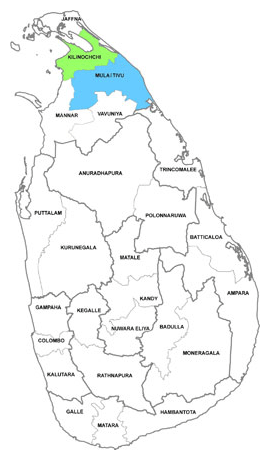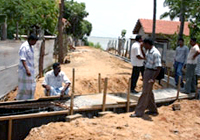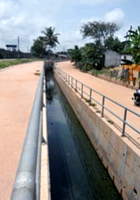Background

Three decades of conflict in Sri Lanka ended in May 2009, displacing more than 450,000 people. In addition to the loss of family assets and livelihoods, the displacements also forced people into poverty. Due to the prolonged conflict, infrastructure has suffered seriously from damage and neglect, substantially affecting the living conditions of the resettled people.
The Project for Rehabilitation of Community Infrastructure and Facilities in the Conflict Affected Areas in Northern Province, Sri Lanka (RCIF) has been framed within the overall objective of contributing to the sustainable rehabilitation and reconstruction of the conflict affected Northern Province of Sri Lanka and to overcome the on-going hardships of the returned and resettled Internally Displaced People (IDPs) due to lack of basic services.
Objectives

This project will benefit returnees in over 80 villages in the districts of Mullaitivu and Killinochchi through the reconstruction and rehabilitation of vital community infrastructure such as internal access roads, drainage systems, preschools, and multipurpose community centres. It will also provide Rain Water Harvesting systems to public buildings and improve the environment through tree planting initiatives. The project will further build capacity of communities and Local Authorities for accessing support through partnership building. Extensive training on leadership, management, construction skills and maintenance of infrastructure facilities will be provided to community members with a special focus on women's participation and empowerment in the project areas.
The overall objective of this project will contribute to sustainable rehabilitation and reconstruction of conflict affected Northern Sri Lanka. The project will directly contribute to the objectives of the Government Rehabilitation Programme, i.e. "facilitate the sustainable return of internally displaced people through rehabilitation of community infrastructure facilities, the generation of employment opportunities and stabilizing communities with local governance structures". The specific objective of the project is to address the reintegration needs of the communities in the Northern Province through sustainable rehabilitation and reconstruction assistance and the improvement of basic services.
The initiatives under the project have been built on the needs identified in the "Community Action Plans" prepared through Community Action Planning (CAP) workshops at village level in the conflict affected areas combined with UN-Habitat's comprehensive understanding of the needs of the affected communities, after 36 months of working with more than 250 post-conflict villages.
The project will be implemented by UN-Habitat in partnership with community based organizations, district administration and local government during a period of two years.
Key Results

- ・Rehabilitation of 60 km of internal access roads including culverts;
- ・Construction of 14 rainwater harvesting facilities in public buildings;
- ・Reconstruction of 14 km of masonry storm water drains;
- ・Reconstruction of 19 community centers;
- ・construction of 18 pre-schools;
- ・Promoting women's participation in decision making and leadership;
- ・Training youth and communities on construction techniques and maintenance of infrastructure facilities;
- ・Training pre-school teachers in the communities;
- ・Training stakeholders on management and sustainability;
- ・Linking communities and local governments through Government field extension networks;
- ・Community green cover increased through planting of 135,000 trees;
- ・DRR features incorporated into the construction of community infrastructure.
Project Approach
UN-Habitat's field tested method for sustainable recovery from disasters, the "People's Process" model, will be adopted to implement this project. This process involves mobilizing the target group into an integrated community. The envisaged action will be developed at Community Action Planning (CAP) workshops where the community members participate in the decision making process. It will also engage the beneficiaries in community contracts (community implementation agreements), in the construction process and create ownership and cost effectiveness in the assets being created.

The advantages of the Community Contract system have been proven over the years in various countries including Sri Lanka, Indonesia, and Afghanistan. As the community is responsible for carrying out the work under the contract, they take on ownership of the product which they create, as well as responsibility for its maintenance. The mechanism ensures that work will be carried out in accordance with acceptable standards of the community and principles of vulnerability reduction and Disaster Risk Reductions. The quality of the work is generally of a higher standard than the work of commercial contractors, as communities are undertaking the work for themselves and will not compromise on quality. The investment on rebuilding will become a cash injection to the beneficiaries. This encourages local entrepreneurship, thereby regenerating the local economy and promoting skills transfers.
The project activities will be implemented by Community Based Organizations (CBOs) in the project locations through community contracts. Project funds will be allocated to benefit communities immediately and directly, by providing grants in the form of Community Implementation Agreements. Physical works will be carried out by CBOs under the contracts, with technical input from UN-Habitat.
Complex work beyond the skills of the local community will be contracted out by the CBOs to small local contractors through the standard bidding process, with the community and technical staff of UN-Habitat responsible for supervising the implementation.
Funds for the community contracts will be channeled in installments to the CBO's bank account through commercial banks. Communities will receive the first installment upon signing of the contract and consecutive installments will be released based on the completion of agreed components of the work and submission of progress reports.
UN-Habitat will establish a comprehensive Management Plan to ensure that the infrastructure facilities developed by the project are maintained by the community and Local Authority in order to ensure long term sustainability. The Local Authorities in the project areas will be involved in the process of reconstruction and rehabilitation from the inception of the project and will take ownership of the infrastructure facilities and be responsible for their maintenance in order to ensure future sustainability of these important public assets. In addition, the district and divisional administration will use the community centres to provide services to community members such as health care and agriculture extension support which will further contribute towards the sustainable use of the buildings.
Development Partners/ Partners
Development Partner: Government of Japan
Partners: Community Based Organizations (CBOs), Local Government and Divisional Coordination Committee
- Catalytic Support to Peacebuilding in Sri Lanka
- Preparation of the Resettlement Plan (RP) for Households Affected by the Rehabilitation of the Kelani Valley (KV) Railway Line in Sri Lanka (Phase I)
- Emergency Shelter Relief for Flood and Landslide Affected Households in Kalutara and Galle Districts of Sri Lanka
- The State of Sri Lankan Cities Report
- Human Development Initiative through Empowerment and Settlement Improvement in the Plantation Settlements in Sri Lanka
- Indian Housing Project in Central and Uva Provinces
- Emergency Shelter Relief for Flood Affected Families in Colombo and Gampaha Districts in Western Province, Sri Lanka (Completed)
- Sustainable Resettlement through Community-Driven Improvement of the Learning Environment in Mannar District, Sri Lanka
- Support My School: Supporting Schools in Northern Sri Lanka with Access to Water and Sanitation Facilities (Completed)
- Project for Rehabilitation of Community Infrastructure, Improvement of Livelihoods and Empowerment of Women in the Northern and Eastern Provinces (RCI) (Completed)
- Rainwater Harvesting in a Water Scarce Small Village in Northern Sri Lanka (Completed)
- Climate Resilient Action Plans for Coastal Urban Areas (Completed)
- Disaster Resilient City Development Strategies for Sri Lankan Cities (Completed)
- Disaster Resilient City Development Strategies for Four Cities in the Northern and Eastern Provinces of Sri Lanka (Phase II) (Completed)
- Rehabilitation of Community Infrastructure and Facilities in the Conflict Affected Areas in Northern Province of Sri Lanka (Completed)
- Improving Living Conditions in Returnee Areas of Sri Lanka through Housing (Completed)
- Indian Housing Project (Completed)
- Support to Conflict Affected People through Housing (Completed)
- Shelter Support to Conflict-affected IDPs in the North of Sri Lanka (Completed)
- Jaffna Tsunami Recovery and Reconstruction Project (Completed)
- Community Recovery and Reconstruction Partnership to Support the People's Process of Rebuilding (Completed)
- Reconstruction of Fish Market in Galle (Completed)
- Rebuilding Community Infrastructure and Shelter in Tsunami-Affected Areas (Completed)
- Lunawa Lake Environment Improvement and Community Development Project (Completed)
- Pro-Poor Partnerships for Participatory Settlement Upgrading (Completed)
- Early Recovery Shelter for IDPs in Batticaloa (Completed)
- Support to the Urbanization Framework
- Post Disaster Housing Coordination Project (Completed)
- Sustainable Cities Programme (Completed)
- Urban Governance Support Project (UGSP) (Completed)
- Rebuilding Communities in North East Sri Lanka (Completed)
- Urban Poverty Reduction Strategy - Colombo (Completed)






































